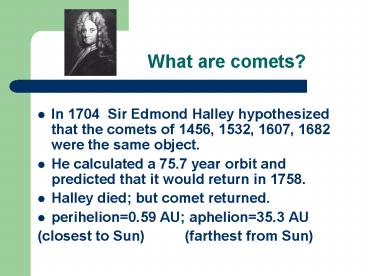What are comets PowerPoint PPT Presentation
Title: What are comets
1
What are comets?
- In 1704 Sir Edmond Halley hypothesized that the
comets of 1456, 1532, 1607, 1682 were the same
object. - He calculated a 75.7 year orbit and predicted
that it would return in 1758. - Halley died but comet returned.
- perihelion0.59 AU aphelion35.3 AU
- (closest to Sun) (farthest from Sun)
2
Halleys comet was at perihelion in 1986
It will return in 2061.
3
Comets are dirty iceballs!
- Nucleus (very small, about 10 km across) rock
ices (mostly H2O and CO2 dry ice, some methane
CH4 ammonia NH3) - Coma (103 to 105 km across) is gaseous. As comet
approaches Sun ices sublime, change from solid to
gas, dust grains loosen and move away - Tails (105 km to 1 AU long)solar wind (steady
stream of solar particles) pushes gas away dust
continues to orbit Sun
4
1997Comet Hale-Bopp
Can you spot the coma, gas tail, and curved dust
tail?
5
Asteroids show up as streaks on photos.
Since they orbit the Sun, they are observed to
move with respect to the stars.
6
Most asteroids lie in the asteroid belt.
- 1801 Ceres was discovered first. Approx.
100,000 lie between Mars and Jupiter.
7
Asteroids are typically cratered and irregularly
shaped.
- Composition
- Carbonaceouscontaining carbon
- Rockymostly silicates
- Metalliciron and nickel rich
- NEAR probe orbited Eros (2000) and crash landed
on it (2001) - Eros is a near-Earth asteroid
- Orbit brings it close to Earth!
8
View of 3 asteroids from spacecraft
50 km
9
Impacts on Earth
- Meteors burn up in the atmosphere meteorites
dont impacts can and do happen - Meteor Crater, Arizona
- Diameter is 1.2 km 50,000 years old
- Projectile was 50 meter diameter, metallic
asteroid - Crater diameter is 1.2 km, 200 m deep
10
How does a small body produce a very large impact
crater?
- A huge amount of energy is released as the body
explodes on impact. - The energy released depends on a bodys mass (m)
and velocity (v). - Energy of motion, kinetic energy (KE) is given by
the formula KE ½ m v2
11
The projectile that exploded on impact and
produced Meteor Crater was equivalent to the
energy of 1000 Hiroshima bombs. 20 megatons!
12
In 1908, an 80 meter stony asteroid exploded over
Tunguska Siberia. The air blast knocked down
trees over 30 km. Windows were broken 600 km
away.
People heard the noise 1000 km away
13
Italian clay65 million years old
Iridium, shocked quartz, soot in layer support
impact hypothesis (Italian coin is the size of a
quarter)
14
Did an impact cause mass extinctions 65 million
yrs. ago?
- Disappearance of 70 species from the fossil
record, including dinosaurs - Evidence for 10 km asteroid impact in
- Worldwide 65 million yr old clay layer with
- Iridium (element 77) rare in crust, but in clay
- Shocked quartzindicates heat pressure
- Sootglobal wildfires
15
What happens when a large (10 km) asteroid or
comet strikes?
- Object explodes (energy billion megatons) on
impact and vaporizes a portion of crust - Molten rock is thrown into atmosphere it falls
back down as a fiery rain igniting forests - Lighter dust stays suspendeddark cold
- Photosynthesis food chain disrupted
- Soot, shocked quartz, iridium dust settles
creating 65 million year old clay layer exposed
at over 100 places on Earth
16
Chicxulub Crater is identified off Yucatan
Peninsula
- 300 km diameter ringed basin
- About 65 million year old
- Could this happen again?
- Yes! It is estimated that more than 10,000
objects approach Earth - Tunguska/Meteor Crater events happen about every
1000 years - A Big One predicted once every 100 million
years
17
Crater is buried beneath Yucatan Penisula and
Gulf of Mexico. This map was made by studying
gravity measurements made in the region.
Compressed layers show crater.

